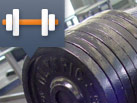
The development of power for rugby players is probably, along with speed, the most sought after physical attribute of them all. The development of maximum strength is a necessary precursor for players to develop and maximise their full power potential, but at the end all rugby players are looking for increased power!
Power can be simply defined as a combination of strength and speed. In other words, power involves the application of force in the shortest amount of time possible, or work performed during a specific period of time.
While absolute strength (the maximum amount of force possible, irregardless of the time frame in which it is produced) is important for rugby performance, it is power which is needed for the rugby player to really perform effectively.
Power is traditionally developed via the explosive lifting exercises like the classical lifts (clean and jerk, snatch), and plyometric training. These are two effective methods for developing athletic power.
Medicine ball training can also be used as a form of plyometric training and can also be an effective tool for developing power.
One advantage of medicine balls revolves around the fact that there exists no need to decelerate the training movement. Using throws and pushes allows the rugby player to develop maximum force through a full range of motion. This is not possible with conventional weight training due to the fact that the bar or dumbbell must be decelerated towards the completion of the movement. Otherwise, the potential for injury is great. On the other hand, a player can throw a medicine ball, releasing the weighted implement without having to slow down or decelerate the action. This in itself is more specific to the activities occurring in rugby. A rugby player running with the ball does not think of slowing down his speed prior to contact with his opponent or try and decelerate as he attempts make a tackle He may visualise “punching through his opponent” explosively on attack and defence. Deceleration would diminish the force delivery and produce an inefficient movement.
As you can see, maximum force development is ballistic in nature. It lacks a deceleration phase.
Another advantage to training with medicine balls is the ability to work with different loads, just as with other forms of resistance training. As such, the principle of overload can be achieved via a systematic, periodised progression as the players abilities improve.
In addition, the various weighted medicine balls can be thrown, pushed or launched from a variety of rugby specific postures and biomechanical positions.
The principle of Specificity can therefore also be incorporated into the players training.
Medicine balls can be thrown against a wall or with a partner. Catching a powerfully delivered throw is also a great stimulus for training the core muscles to act as shock absorbers or decelerators. As such, the concept of force acceptance, or force reduction can be applied to the players training.
As with any form of training and conditioning, medicine ball work should be periodised in terms of volume, intensity and frequency of training, In addition, due to the high degree of central nervous system stimulation and considerable forces imposed on the body during this type of conditioning work, medicine ball training must be integrated into the total program with respect to the other training activities. These may include other forms of resistance training (i.e. weights); speed, quickness and agility drills; and tactical and skill work.
Include medicine ball work into your training programmes, you will benefit greatly.
Steve Mac | rugbyIQ.com conditioning specialist

